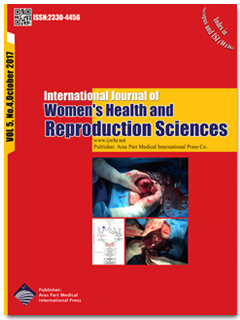| Original Article | |
| Lifestyle Related Fertility Disorders in North Jordan: Potential for Improvement | |
| Jehan Mahmoud Hamadneh1, Zouhair Amarin1, Shereen Hamadneh2, Nail A. Obeidat1, Manal Kassab3, Mahmoud Bani Hani4 | |
| 1Department of Obstetrics and Gynaecology, Faculty of Medicine, Jordan University of Science and Technology (JUST), Irbid, Jordan 2Department of Maternal Child Health, Faculty of Nursing, Al-Albayt University, Mafraq, Jordan 3Department of Maternal and Child Health, Faculty of Nursing, Jordan University of Science and Technology, Irbid, Jordan 4Oncoplastic Breast Specialist, Medical Director, Princess Basma Teaching Hospital, Irbid, Jordan |
|
|
IJWHR 2017; 5: 264-269 DOI: 10.15296/ijwhr.2017.45 Viewed : 3915 times Downloaded : 3399 times. Keywords : Behavior, Fertility, Lifestyle |
|
| Full Text(PDF) | Related Articles | |
| Abstract | |
Objectives: To explore the prevalence rates of lifestyle practices linked to fertility disorders. Materials and Methods: A cross-sectional descriptive study, using a validated questionnaire, was conducted among sub-fertile couples attending the fertility center at Jordan University of Science and Technology between February 2013 and August 2014. Results: A total of 126 couples took part in the study. The average length of sub-fertility was 4.2 years. The mean age of the women was 31 years, of whom 70% were <35 years of age. Over 6% engaged in regular sporting activity. Less than 1% of women smoked more than 5 cigarettes per day. For male partners, the mean age was 36 years, of whom 85.7% were <45 years of age. Over 22% engaged in regular sporting activity. None were taking anabolic steroids on a regular basis. Almost 39% of men smoked more than 5 cigarettes per day. The percentage of patients that took advantage of the woman?s ?fertile days? on 6 occasions over the preceding 6 months was 29.37%. Low stress was encountered in 24.21%, intermediate stress in 40.08%, and high stress in 34.52% of couples. The most frequent cause of stress was delay in achieving pregnancy. Almost 4% of women displayed 2 or more risk factors, compared to 11.1% in their male counterparts. Conclusion: Behavior-related fertility disorders are common in Jordan. Modifying lifestyle factors for better reproductive health is highly recommended. |
Cite By, Google Scholar
Google Scholar
PubMed
Online Submission System
 IJWHR ENDNOTE ® Style
IJWHR ENDNOTE ® Style
 Tutorials
Tutorials
 Publication Charge
Women's Reproductive Health Research Center
About Journal
Publication Charge
Women's Reproductive Health Research Center
About Journal
Aras Part Medical International Press Editor-in-Chief
Arash Khaki
Mertihan Kurdoglu Deputy Editor
Zafer Akan






















